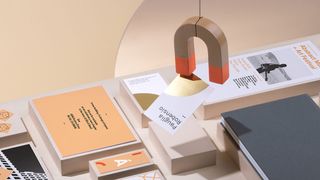Build a bigger profile in 2019
Strengthen your industry standing and tap into new markets with these 4 top tips.
To forge a career as a creative professional, you need talent. You also need a certain amount of technical knowledge and skills in the area you're working in. But neither of these things in silo are a ticket to success. To get commissions and attract customers, you need people to know you and your work. In this article we'll explore some top tips for building your profile within your creative field, whether you're a designer, illustrator or artist.
01. Speak at events

Speaking at industry events is an awesome way to help raise your profile. Not only does it enable you to show off your skills and cement your position as an authority in your particular specialism, but it's also an incredible way to get your name known within the industry – you've got a captive audience of designers and artists sat right in front of you, after all. Many high-profile designers credit speaking at events with opening new doors in their career path (don't believe us? Take a look at point three here).
If you have knowledge and expertise to share, email event organizers and pitch your idea for a talk. Hosts are always looking for exciting new voices, so don't be nervous about getting in touch. Once you've snagged a speaker slot, don't miss the obvious opportunities for self-promotion (it's surprisingly easy to do). Introduce yourself clearly, explain what it is you do at the start, and use your own work for examples within your talk.
Also make sure your audience knows exactly how to get in touch with you – that means including your website URL and social media handles on your slides. All of this can feel a bit awkward as a new speaker, but it won't sound odd to your audience. Promise.
If you're not quite ready to get on stage yet, attending events as an audience member can still be a savvy career move. They're a great place to mingle and network (more on that later), as well as providing a good indication of what the hot topics are in the industry at the time.
02. Be smarter with social media

It's no secret that social media can be an incredible promotional tool for designers and artists. Different platforms have different strengths. Instagram is a no-brainer for creatives – the visually led platform is ideal for those wanting to show off new designs, and the Stories feature provides a relatively risk-free place to share works-in-progress. The downside is that you aren't able to insert clickable links into your comments, so you need to rely on people visiting your profile to get them onto your main portfolio site.
Twitter really shines when it comes to communicating with fellow creatives and keeping up to date with industry happenings – essential if you want to build your network. Finally, there's Facebook. While you need to be careful to abide by Facebook's rules about frequency of posts and language used, it can be a great place to raise your profile, with digital artists in particular noting how important it is in their self-promo efforts. For examples of how leading creatives have used different platforms to raise their profile, take a look at this guide to making social media work for you.
A word of warning – avoid a scattergun approach, pick two or three platforms that work with your specialism, and focus your efforts there. A good way to see if they're worth the effort is to see if (and how) the big players in your particular field are using these platforms and follow their lead.
03. Get better at networking

The very word may make you groan internally, but knowing how to network is vital to raising your professional profile. The golden rule is not to treat it like a sales pitch, but rather an opportunity to connect with likeminded people and exchange information. Be polite and friendly and you're well on your way.
Chances are, if you're at a creative event, you'll have things in common with the others who are attending – so there should be no need to feign interest. Make sure you pay attention to what the other person is saying, and you'll naturally make more of a connection than you would if you went for a hard-sell approach. That said, you do need to make sure you maximize the potential of your networking for new business, which brings us on to our final point...
04. Don't forget your business cards

Having a stack of business cards on hand to give to new contacts means they have all the information they need right there in their pocket. And if you have a well-designed, interesting business card, your new contact is all the more likely to get in touch.
To nail the perfect business card, first of all you must get to grips with the essentials of designing for print (trim, bleed, image resolution, color profile and so on). You also need to ensure all the essential information (name, specialism, website URL, contact details) is both present and clearly legible. Beyond that, you can be as creative as you like. Special finishes can really give your business card the edge; MOO offers gold foil, spot gloss and raised spot gloss to make a card stand out. With MOO's Printfinity package, you can even mix things up properly and print a whole range of different business card designs. You're an artist, after all – so use your talents to make your design shine.
Related articles:
- 10 steps to go freelance this year
- The pro's guide to creating memorable business cards
- How to project your work onto the global design stage
- 6 surefire ways to build your creative network
- Nail the art of networking
- 4 brilliant personal logos and why they work
- 3 tips for crafting stunning promotional material
- Create better business cards in less than five minutes
- 5 ways to earn more as a freelancer
- 5 ways to handle tricky clients as a designer

Thank you for reading 5 articles this month* Join now for unlimited access
Enjoy your first month for just £1 / $1 / €1
*Read 5 free articles per month without a subscription

Join now for unlimited access
Try first month for just £1 / $1 / €1
Get the Creative Bloq Newsletter
Daily design news, reviews, how-tos and more, as picked by the editors.
Ruth spent a couple of years as Deputy Editor of Creative Bloq, and has also either worked on or written for almost all of the site's former and current design print titles, from Computer Arts to ImagineFX. She now spends her days reviewing small appliances as the Homes Editor at TechRadar, but still occasionally writes about design on a freelance basis in her spare time.
Related articles
-

-

-

-

